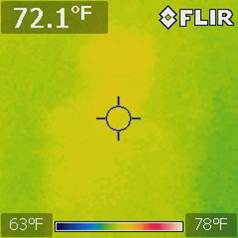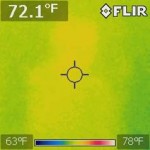
By David Hurtado

If there’s something strange in your neighborhood, who you gonna call? College students armed with ghost detecting tools, of course.
Students enrolled in Sean Daley’s Anthropology of the Paranormal and Supernatural class embarked on a trip to the Crescent Hotel in Eureka Springs, Ark. The hotel was previously used as a women’s college and cancer hospital.
Daley, associate professor, Anthropology, said he chose the location because of its reputation and the experiences it would provide to students as part of a class activity.
“Me and some of my colleagues had the opportunity to go down there over this past summer and we had a good experience down there,” he said. “The hotel management was willing to work with us and allow us to bring students in. It’s a place with a good reputation for having paranormal phenomena.”
Daley said when the building was being utilized as a hospital for people stricken with cancer, at least several hundred patients died within its walls. During the hotel’s time as a women’s college, a student hung herself. He also said a few construction workers died during the building’s construction.
Rachel Berry, student, said she went on the academic trip because of her interest in the paranormal. She also said previous trips Daley’s class took were more local and less advertised than the Crescent Hotel.
“I’m really interested in studying anything anthropology, especially when it comes to paranormal [activity],” Berry said. “I had heard a lot of things about the hotel, like that it was haunted or that there was stuff going on there. I thought it would be pretty interesting to go out somewhere that was a little bit more well-known for things like that.”
Students attending the paranormal endeavor were divided into groups of five or six and then placed with a chaperone in different sections of the hotel. Students were outfitted with thermal imaging cameras and flashlights and spent about an hour in different areas before rotating to a new one. The investigations began at 9 p.m. and lasted until 3:30 a.m.
Students also carried K2 meters, which are part of a class of instruments known as electromagnetic field detectors (EMFs). When exposed to a magnetic field, an EMF creates an electrical current within its circuitry. The relative strength of the field is displayed on a 5-LED light-up scale.
“The group I was with, half of them got something; the other half, which I was a part of, did not,” said Andrew Novak, student. “We think we got something; we’re not 100 percent sure yet. We went into room 218, which is supposedly haunted by this guy named Michael, the top floor and around the outsides of the hotel.”
Daley said the class is still sifting through evidence gathered from the hotel, but have already made a discovery from an image taken from a thermal imaging camera. He said in previous trips students have reported seeing small objects move and hearing disembodied voices in rooms no one else was in.
The Atlantic Paranormal Society (TAPS) is a professional group of paranormal investigators who attempt to disprove alleged paranormal activity.
“Back in 2005, [TAPS] caught a very famous photo at the Crescent of what looks to be a person standing in front of a walker in the morgue,” he said. “We actually caught the same outline. It was in the same place they caught their outline.”
Daley said he takes students on ghost hunting trips because he wants students to put themselves out in the world and experience different cultures firsthand.
“It’s great to read about different cultures, beliefs and perspectives in books; it’s great to watch videos about it, but you need to get out there and you need to interact with people,” he said. “That’s what anthropologists do. It gives students an opportunity to get out there and interact with people at the hotels, at the museums; take it from the classroom into the real world.
“There’s been a growing interest in the past few years in paranormal research and I want my students who are interested in this to learn how to do it properly. Like anything else, you can go out there and learn how to do it right or you can cut corners. When you’re talking about things like ghosts, demons, aliens, cryptids, things like Bigfoot, most people have a hard time believing in this stuff to begin with.
“If you’re going to go out there and try to capture evidence, you need to make sure you evidence is as legitimate as possible,” Daley said. “I want my students to learn if you’re going to go out and do this stuff, how to do it in such a way that you don’t come across as a joke nor your potential evidence.”
Contact David Hurtado, features editor, at dhurtado@jccc.edu.





















